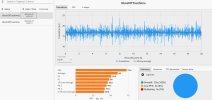So tried the Ghost of Tsushima PC port, quick impressions:
The Good/Decent:
- Performance with the High preset, at least in the opening gameplay scenes, isn't actually that bad for my 3060. High, very high textures, 16X AF, 4k with DLSS performance is just below a locked 60. Something like a 3060 ti could likely get a very stable 60, at least in these areas. The Ultra shadows+LOD give a big hit to performance so on high the game isn't as exorbitantly demanding as it first appeared.
- Consistency of framerate when not GPU limited is excellent. No huge spikes at all.
- DLSS performance looks very good, better than 4K CBR. However...
The bad:
- Outside of shadows/draw distance, scaling with other graphical options is basically zero, at least on my rig. Dropping down reflections, volumetrics etc has very little uplift to performance.
- DLSS looks very good in most instances, but like DF showed, it messes up with DOF - hard. Considerable specular aliasing/flickering. The particle effects are fine when dof isn't engaged, but as dof can be active in gameplay for distant objects, you can have extended gameplay sequences with lots of flickering pixels in the distance.
- DLSS also doesn't take motion blur into account for certain elements - like a waterfall early on has significant shimmering with motion blur. Also once again, no separation for camera and object blur.
- Ground textures without grass, like mud, are brutal. This isn't really the fault of the port as this is how the original looks and I would never expect a texture overhaul for the PC version, but I gotta think something could have been done to help this single asset look less like a trilinear filtered texture from 10 years ago. A detail map? Dunno, just anything.
The Ugly:
- Frame/camera pacing. It is indeed fucked, at least at 60hz. Constant microjudder as Alex showed. Rivatuner/Special K cannot fix it.
- Like Forbidden West, Dynamic Res (at least on my system), is broken. It's constantly overshooting by using a higher DLSS preset in scenes that results in more of a 'lock' to ~57 fps instead of 60. For example, a scene where I would get a solid 60 with DLSS performance gives me 57-58 with dynamic. It will never go to 60.
So overall, a little better performance than I expected, but it's annoying that this it the second Nixxes game in a row for me that has problems with post-process reconstruction artifacts (forbidden west also has issues with motion blur + DLSS and some vegetation), poor camera/frame pacing and a faulty (?) dynamic res. Like, reconstruction fucking up with post process effects + stuttering are my two big bugaboos!
As mentioned Nixxes is fantastic at consistent
framerates, but it's largely for naught if the viewport movement doesn't reflect that consistency - a constant small microjudder is better than large shader stutters I guess, but it's still an anomaly compared to 95% of other games, including most of Nixxes past work (albeit come to think of it, even Ratchet and Clank had some pacing anomalies but they could be
largely fixed with a Rivatuner cap). So perhaps something in their workflow/engine, or how they're evaluating actually presented frames has changed since, it's not a good sign they're not picking these up before release.
Hopefully these can be addressed, as at least the camera pacing is a deal-breaker for me - but as it's likely not something you're going to notice unless you're using a gamepad and slowly pan the scene so it may not be highlighted by the majority of PC users, thankfully at least DF shone a light on it so we'll see.
Edit: Hmm, maybe at least on my system this isn't just a camera problem! The actual framerate is staying locked at 60, but whoa - look at this mess:

This is what I would expect if I was running the game at PCIe 3.0 8X (which btw - would still be uh, bad!) , but I've confirmed my slot is at least identifying as 4.0 16X.
Is there a throughput utility I can use to see if my PCIe bandwidth is borked?







